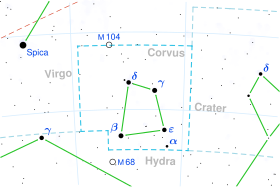| Observation data Epoch J2000.0 Equinox J2000.0 (ICRS) | |
|---|---|
| Constellation | Corvus |
| Right ascension | 12h 32m 04.22653s[1] |
| Declination | −16° 11′ 45.6165″[1] |
| Apparent magnitude (V) | 4.29–4.32[2] |
| Characteristics | |
| Spectral type | F2 V[3] |
| U−B color index | +0.00[4] |
| B−V color index | +0.38[4] |
| R−I color index | +0.18[5] |
| Variable type | Suspected[2] |
| Astrometry | |
| Radial velocity (Rv) | −2.80 ± 1.5[6] km/s |
| Proper motion (μ) | RA: −425.17[1] mas/yr Dec.: −57.23[1] mas/yr |
| Parallax (π) | 54.70 ± 0.17 mas[1] |
| Distance | 59.6 ± 0.2 ly (18.28 ± 0.06 pc) |
| Absolute magnitude (MV) | 2.99[7] |
| Details | |
| Mass | 1.52[8] M☉ |
| Radius | 1.61[9][a] R☉ |
| Luminosity | 5.06±0.05[8] L☉ |
| Temperature | 7,000[8] K |
| Rotational velocity (v sin i) | 68 ± 2[10] km/s |
| Age | 1.4±0.3[11] Gyr |
| Other designations | |
| Database references | |
| SIMBAD | data |
| ARICNS | data |
Eta Corvi (Eta Crv, η Corvi, η Crv) is an F-type main-sequence star, the sixth-brightest star in the constellation of Corvus. Two debris disks have been detected orbiting this star, one at ~150 AU, and a warmer one within a few astronomical units (AU).
- ^ a b c d e van Leeuwen, F. (2007). "Validation of the new Hipparcos reduction". Astronomy and Astrophysics. 474 (2): 653–664. arXiv:0708.1752. Bibcode:2007A&A...474..653V. doi:10.1051/0004-6361:20078357. S2CID 18759600.
- ^ a b Kukarin, B.W.; et al. "NSV 5690". Institute of Astronomy of Russian Academy of Sciences/Sternberg Astronomical Institute.
- ^ Gray, R. O.; Corbally, C. J.; Garrison, R. F.; McFadden, M. T.; Bubar, E. J.; McGahee, C. E.; O'Donoghue, A. A.; Knox, E. R. (2006). "Contributions to the Nearby Stars (NStars) Project: Spectroscopy of Stars Earlier than M0 within 40 pc – The Southern Sample". The Astronomical Journal. 132 (1): 161–170. arXiv:astro-ph/0603770. Bibcode:2006AJ....132..161G. doi:10.1086/504637. S2CID 119476992.
- ^ a b Mermilliod, J.-C. (1986). "Compilation of Eggen's UBV data, transformed to UBV (unpublished)". Catalogue of Eggen's UBV Data. Bibcode:1986EgUBV........0M.
- ^ Hoffleit, D.; Warren, W. H. Jr. "HR 4775". Bright Star Catalogue (5th Revised ed.). Centre de données astronomiques de Strasbourg. Retrieved 2008-11-19.
- ^ Gontcharov, G. A. (2006). "Pulkovo Compilation of Radial Velocities for 35 495 Hipparcos stars in a common system". Astronomy Letters. 32 (11): 759–771. arXiv:1606.08053. Bibcode:2006AstL...32..759G. doi:10.1134/S1063773706110065. S2CID 119231169.
- ^ Holmberg, J.; et al. (2007). "HD 109085". The Geneva-Copenhagen Survey of Solar Neighbourhood. Centre de données astronomiques de Strasbourg. Retrieved 2008-11-19. See also Nordström, B.; et al. (2004). "The Geneva-Copenhagen survey of the Solar neighbourhood: Ages, metallicities and kinematic properties of ~14,000 F and G dwarfs". Astronomy & Astrophysics. 418 (3): 989–1019. arXiv:astro-ph/0405198. Bibcode:2004A&A...418..989N. doi:10.1051/0004-6361:20035959. S2CID 11027621.
- ^ a b c Lebreton, J.; Beichman, C.; Bryden, G.; Defrère, D.; Mennesson, B.; Millan-Gabet, R.; Boccaletti, A. (2016-02-01). "MODELS OF THE η CORVI DEBRIS DISK FROM THE KECK INTERFEROMETER, SPITZER, AND HERSCHEL". The Astrophysical Journal. 817 (2): 165. arXiv:1511.05207. Bibcode:2016ApJ...817..165L. doi:10.3847/0004-637X/817/2/165. ISSN 0004-637X.
- ^ Absil, O.; Defrère, D.; Foresto, V. Coudé du; Folco, E. Di; Mérand, A.; Augereau, J.-C.; Ertel, S.; Hanot, C.; Kervella, P.; Mollier, B.; Scott, N.; Che, X.; Monnier, J. D.; Thureau, N.; Tuthill, P. G. (2013-07-01). "A near-infrared interferometric survey of debris-disc stars - III. First statistics based on 42 stars observed with CHARA/FLUOR". Astronomy & Astrophysics. 555: A104. arXiv:1307.2488. Bibcode:2013A&A...555A.104A. doi:10.1051/0004-6361/201321673. ISSN 0004-6361.
- ^ Cite error: The named reference
morawas invoked but never defined (see the help page). - ^ Cite error: The named reference
Lissewas invoked but never defined (see the help page). - ^ "SIMBAD query result: NSV 5690 – Variable Star". Centre de données astronomiques de Strasbourg. Retrieved 2008-11-19.
Cite error: There are <ref group=lower-alpha> tags or {{efn}} templates on this page, but the references will not show without a {{reflist|group=lower-alpha}} template or {{notelist}} template (see the help page).
